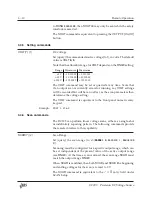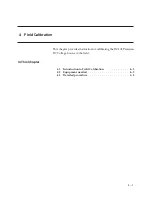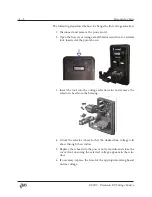
3 – 18
Remote Operation
3.5
Status model
The DC205 status registers follow the hierarchical IEEE–488.2 format.
status registers
A block diagram of the status register array is given in Figure 3.1.
TBD
Status
/
register model not yet finalized
Figure 3.1: Status Model for the DC205 Precision DC Voltage Source
There are three categories of registers in the status model of the
voltage source:
Event Registers : These read-only registers record the occurrence of defined
events within the voltage source. If the event occurs, the corre-
sponding bit is set to 1. Upon querying an event register, any
set bits within it are cleared. These are sometimes known as
“sticky bits,” since once set, a bit can only be cleared by reading
its value. Event register names end with
SR
or
EV
.
Enable Registers : These read
/
write registers define a bitwise mask for their cor-
responding event register. If any bit position is set in an event
register while the same bit position is also set in the enable
register, then the corresponding summary bit message is set in
the Status Byte. Enable register names end with
SE
or
EN
.
Status Byte : This read-only register represents the top of the status model,
and is populated with summary bit messages and interface
condition bits. Enabled bits within the Status Byte generate the
remote Request Service event.
At power-on, all status registers are cleared.
3.5.1
Status byte (SB)
The Status Byte is the top-level summary of the DC205 status model.
When enabled by the Service Request Enable register, a bit set in the
Status Byte causes the MSS (Master Summary Status) bit to be set.
Weight
Bit
Flag
1
0
undef (0)
2
1
undef (0)
4
2
undef (0)
8
3
undef (0)
16
4
undef (0)
32
5
ESB
64
6
MSS
128
7
undef (0)
DC205 Precision DC Voltage Source








































